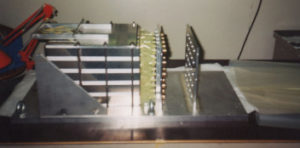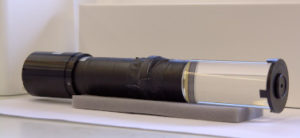PageContent
Development of new detectors
+ V. Cafaro e V. Giordano: Detector based on scintillators and photomultipliers or SiPMIn the early 90s we started working on scintillators based on light collection using WLS fibers (see photo below) and in particular, we built the STIC.
STIC is a foreward calorimeter to measure luminosity where this latter is read through the use of tetrodes.
For the Delphi experiment (at LEP Cern), we created a system where counters angled at 40 degrees are mounted inside a magnet and a veto system is mounted on the beam pipe. The veto is read by photomultipliers placed outside the magnetic field.
In more recent years we built counters read by CMS Beam Halo Counter Detector photomultipliers (CMS DN 2012) and, always for CMS, we worked on quartz read by photomultipliers.

Even more recently, we engaged in the creation of various prototypes of counters read by silicon photomultiplier for the Super B and SHIP experiments.
+ D. Cavazza: timing-SiPM e Ultra Fast Silicon Detectors
I study the SiliconPhotoMultiplier (MPPC / SiPM) and specifically the measures, characterizations and configurations for timing, in collaboration with several students that, with my support, authored experimental theses on detectors.
In recent years I also extended my analysis to new generation silicas, UFSD (Ultra Fast Silicon Detectors) and LGAD (Low Gain Avalanche Detectors). These analysis led me to develop scintillator detectors (direct contact or optical fiber) and both CAMAC and VME acquisition systems all interfaced via Labview-based DAQ.












